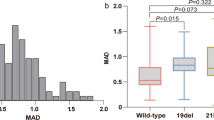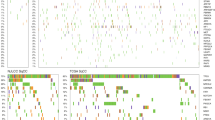Abstract
Some studies have suggested that the S allele of the MYCL oncogene, which results from an intragenic EcoRI restriction fragment length polymorphism (RFLP), may be associated with cancer susceptibility. In addition, this allele has also been linked to metastases and adverse survival in certain cancers, although studies of lung cancer patients from different populations have yielded controversial results. We studied 108 cases of surgical resected non-small-cell lung cancer (NSCLC) and found no evidence that MYCL genotypes were associated with tumour progression or a worse prognosis. However, the presence of loss of heterozygosity (LOH) at this chromosome 1p32 locus correlated significantly with regional lymph node involvement, as well as advanced TNM stage. These data indicate the existence of a chromosome 1p candidate tumour-suppressor gene(s), possibly in linkage disequilibrium with the EcoRI RFLP in specific populations, which appears to play a role in determining tumour progression in NSCLC. Refined mapping of the critical region of loss should help attempts to identify and clone the candidate gene.
Similar content being viewed by others
Author information
Authors and Affiliations
Rights and permissions
About this article
Cite this article
Fong, K., Kida, Y., Zimmerman, P. et al. MYCL genotypes and loss of heterozygosity in non-small-cell lung cancer. Br J Cancer 74, 1975–1978 (1996). https://doi.org/10.1038/bjc.1996.662
Issue Date:
DOI: https://doi.org/10.1038/bjc.1996.662
- Springer Nature Limited
This article is cited by
-
SPAG6 and L1TD1 are transcriptionally regulated by DNA methylation in non-small cell lung cancers
Molecular Cancer (2017)
-
Expression of the candidate tumor suppressor gene hSRBC is frequently lost in primary lung cancers with and without DNA methylation
Oncogene (2005)
-
Topographical distribution of allelic loss in individual lung adenocarcinomas with lymph node metastases
Modern Pathology (2004)




